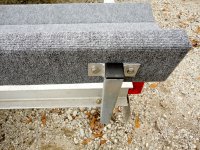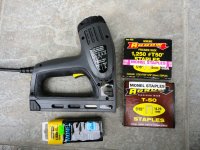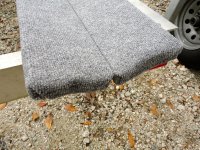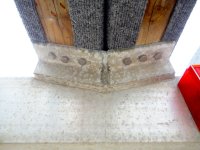thataway
Well-known member
- Joined
- Nov 2, 2003
- Messages
- 21,702
- Reaction score
- 74
- C Dory Year
- 2007
- C Dory Model
- 25 Cruiser
- Hull Identification Number
- DOR25652A707
- Vessel Name
- thataway
After a few years in the Florida sun the bunks need to be recarpeted.
This is the Caracal trailer (an 18 Center Console foot Cat), and although much of the old carpet was OK--wood was showing thru at the very end, there was some corrosion on the mounts, and some wood deterioration.
We used an air driven impact wrench to remove the 1 1/2" x 3/8" lag bolts which held the wood to all of the bunk supports. The same wrench was used to re-install the bolts, and hand tightened with a hand wrench.
We found some corrosion on the aluminum angle brackets on the bottom bunk boards. Those were cleaned up with a power wire brush in a 4" grinder. After these were cleaned up, washed and dried, they were filled with West Systems Epoxy thickened with Cabosil. The side bunks are galvanized. Those pads were rusted; they were wire brushed, treated with "Naval Jelly", primed and then sprayed with liquid galvanizing paint. We launch in brackish water, and wash the trailer after each launch. The prior owner launched in salt water, and we suspect did not wash the trailer.

After the boards were cleaned, any defects were filled with epoxy thickened with Cabisil. The bolt holes were , were also filled with a small amount of thickened epoxy. The new carpet (from Lowes--outdoor polypropylene ) was installed with Monel Staples.

We used 3/8 to 9/16" length staples, the longest in the ends. Care is taken to make sure that there are no staples where they could scratch the boat at the ends. The lower end is doubled under the upper to give extra padding at the end of the bunk board.

The side bunks and forward bow bunk are wrapped completely around the board, and the outside layer is oriented away form the hull on the bottom:

The bottom of the lower bunk is left bare of carpet in the center to allow drainage.

Finally the finished bunks.

This is the Caracal trailer (an 18 Center Console foot Cat), and although much of the old carpet was OK--wood was showing thru at the very end, there was some corrosion on the mounts, and some wood deterioration.
We used an air driven impact wrench to remove the 1 1/2" x 3/8" lag bolts which held the wood to all of the bunk supports. The same wrench was used to re-install the bolts, and hand tightened with a hand wrench.
We found some corrosion on the aluminum angle brackets on the bottom bunk boards. Those were cleaned up with a power wire brush in a 4" grinder. After these were cleaned up, washed and dried, they were filled with West Systems Epoxy thickened with Cabosil. The side bunks are galvanized. Those pads were rusted; they were wire brushed, treated with "Naval Jelly", primed and then sprayed with liquid galvanizing paint. We launch in brackish water, and wash the trailer after each launch. The prior owner launched in salt water, and we suspect did not wash the trailer.

After the boards were cleaned, any defects were filled with epoxy thickened with Cabisil. The bolt holes were , were also filled with a small amount of thickened epoxy. The new carpet (from Lowes--outdoor polypropylene ) was installed with Monel Staples.

We used 3/8 to 9/16" length staples, the longest in the ends. Care is taken to make sure that there are no staples where they could scratch the boat at the ends. The lower end is doubled under the upper to give extra padding at the end of the bunk board.

The side bunks and forward bow bunk are wrapped completely around the board, and the outside layer is oriented away form the hull on the bottom:

The bottom of the lower bunk is left bare of carpet in the center to allow drainage.

Finally the finished bunks.


